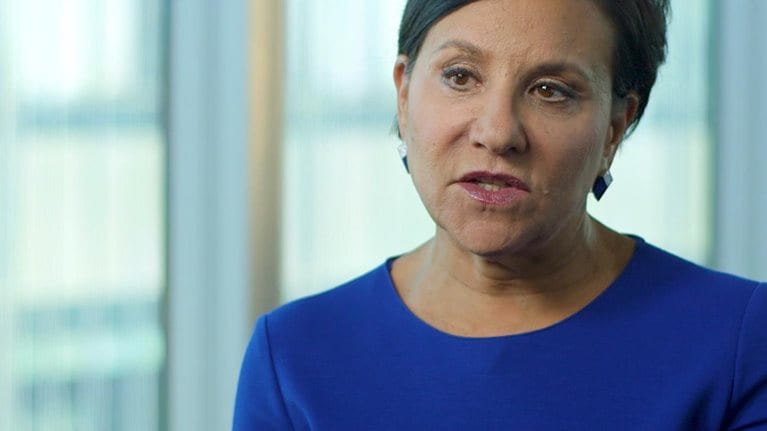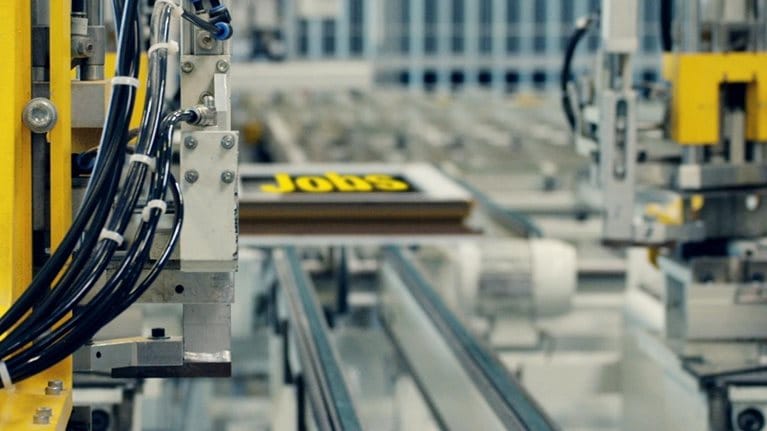Few jobs in today’s economy are unaffected by the rapid pace of technological change. Employers are increasingly aware that workers need to continually upgrade their skills to keep up—and traditional forms of education alone won’t suffice.
In response, society has embarked on a period of “great experimentation,” with educators, employers, governments, and philanthropists reaching across sectors and national boundaries to develop new ways of sustaining a productive workforce. So says Kathleen McLaughlin, chief sustainability officer for Walmart and president of the Walmart Foundation.
In a recent conversation with McLaughlin in her Bentonville, Arkansas, office, she described how technology has changed the very nature of work. She discussed both the importance of lifelong learning and how to execute it most effectively.
Interview transcript
McKinsey: From your perspective as a leader of a foundation for a global retail company, what are key challenges and opportunities in workforce development?
Kathleen McLaughlin: I think the challenges are mostly driven by changes in technology. Certainly for a company like Walmart, we’re now a tech company as much as a retail company. So the diversity of skills required to advance in a place like Walmart and the opportunities available through many different career paths are unlike anything before.
Yes, it has to do with the availability and affordability of technology and what it can do, but, more important, it’s driven by customers and how they want to shop. The ability to order groceries on your mobile device and then pick up your order on the way home from work at five o’clock—that’s a convenience that people really want. So we follow customer needs and then work them back into our retail operation to change the way that we order the goods, transport them, and make them available for people. These trends in retail related to assortment, convenience, and affordability are universal, but they play out differently in one market versus another.
McKinsey: Given how the world has changed, it seems that even entry-level positions are exposed to technology in new and changing ways. Is this a global phenomenon?
Kathleen McLaughlin: The trend that we’re seeing around the need and the increasing engagement of training people already in the workforce is indeed a global phenomenon. It takes a slightly different form in, say, India, than it would in the US; it’s different in Canada than it is in Mexico. The Chinese retail market, for example, may leapfrog what’s going on in North America in terms of digital solutions for people to order and receive goods. In China, there are whole flotillas of people on bikes delivering products that customers ordered online, which you don’t really see in North American cities. While I think you’ll see things evolve a little differently in different markets around the world, nearly all will be using digital tools and data to help people to order and organize their shopping. But technological change is a constant around the world. As a global employer, we see these things happening everywhere.
This digital transformation creates new jobs, but, more important, it changes the nature of jobs, even entry-level ones. Walmart has cashiers, but increasingly those cashiers are hosting self-checkout lanes, which help many of our customers to move out of the store more quickly. We need employees to support those customers, to coach them, to help them, to answer questions. That’s a different form of cashier. What we find is that, at the heart of our roles, there is still a customer service need; it’s just the way that they serve the customer will be a lot different going forward.
McKinsey: What is the right role of employers in making sure that the incumbent workforce can both meet current expectations and thrive in the future?
Kathleen McLaughlin: I think that 10 or 15 years ago people might not even have understood what it meant to develop the skills of incumbent workers, or why that would that be important. It’s really encouraging to me that it’s now just accepted that developing existing workers must be done. Most employers understand that skill development is critical to value creation, and they believe and see that better skills do correlate with higher employee retention.
Last year, the Walmart Foundation funded a US National Skills Coalition study that showed that, in the nation’s service sector—not just retail but also hospitality and healthcare—two-thirds of frontline workers have basic literacy gaps and three-quarters have numeracy gaps. And these people aren’t new to the sector; in many cases, they have been in the sector for quite some time. A significant number of them are supervisors. But many can’t fully perform their jobs because of these basic deficiencies. So the question is: How do employers help these people acquire skills that will help them move up? Well, retail is a great place to do that.
There are so many skills that people can just learn on the job in retail: problem-solving skills, customer service skills, and, to some extent, technology skills. For example, Walmart’s associate training for entry-level workers called Pathways is completed within the first 90 days and helps associates gain vital retail job skills such as communication, customer service, merchandising, and teamwork.
So, to improve workforce development in our society, we need to rewire how it works. What is the role of employers? Educators? The workers themselves? What should the role of government and workforce boards be? All of us need to evolve and work in new ways, so lifelong learning can be easy and effective.
McKinsey: What concrete steps have been taken toward developing new, successful approaches to workforce development?
Kathleen McLaughlin: We are at a time of great experimentation. I don’t think we’ve solved it yet, but there are many, many experiments and initiatives in which people are reaching across sectors in new and different ways. Community colleges are partnering with employers to say, “How do we change what we’re offering so that it’s more relevant to on-the-job success?” City and state governments are collaborating with employers and with education providers. Tech companies are innovating and developing new approaches for learning what people can do remotely or with flexible schedules.
Employers themselves are attempting to solve both near-term problems and forward-looking ones with many successful in-house programs. There are 200 Walmart Academies across the country, for example. We’ve trained 325,000 Walmart associates through them in the past couple of years in very job-relevant skills.
We recently announced a program to provide employees with an accessible and affordable path to gaining an associate’s or bachelor’s degree. For about $1 a day, they can pursue a degree in supply chain or business management. In addition, employees gain college credit for our work-based Academy training—a head start toward a degree. The Walmart Foundation also recently announced a joint grant investment with Google that will funnel resources to multiple organizations that are experimenting with solutions in reskilling the US workforce. We—a tech company and a retailer—are collaborating because we both have this vision of how we need to accelerate into the future of helping people acquire skills on the job.
Whether they’re retailers, tech giants, education technology providers, government agencies, or nonprofits, the whole workforce development system is engaging in a way we’ve never seen before. What’s exciting for me is thinking about how we might transition from this time of great experimentation to more coordinated, collective action.
McKinsey: Many experts have pointed to skills credentialing as a game changer for career advancement. Do you agree?
Kathleen McLaughlin: Yes, that’s one of the biggest things that’s changed in the past ten years. Educators, governments, retail employers, and workforce boards have collectively recognized that we need to find effective ways not just to accelerate skill acquisition but also to give people something to show for it. They need a marketable proposition in the employment market.
Not everybody can go back to school to earn an associate’s or bachelor’s degree, especially if they’re already working full time and have family obligations. We need to implement best practices for how people can acquire skills and create a more integrated system of credentials, so that we can recognize people for the skills they have as they earn them and reward them with career advancement.
What’s exciting for me is thinking about how we might transition from this time of great experimentation to more coordinated, collective action.
McKinsey: Does Walmart issue credentials as part of the Walmart Academy program?
Kathleen McLaughlin: Walmart is approaching the issue of credentialing by, first, figuring out the relevant skills and most effective training for particular jobs. Those might be technical skills, so-called soft skills such as interpersonal skills, or even problem-solving skills, which are also really important. Then we have to determine how we can certify that somebody has them. We and many others are working on badges or certifications or some form of credential to signify that our workers have acquired certain skills. Our philosophy is that ultimately it needs to be a free market, but, as a society, it would be ideal if we could all agree on the standards required for certain kinds of roles and then start to issue certifications against those standards.
So, for example, we might say that to be an effective hourly supervisor, a person needs good problem-solving and leadership skills and a good technical understanding of retail operations with digital skills. Then we decide, what are the markers of those skills? Well, a marker might be an associate’s or bachelor’s degree in retail management, but it might be that they graduated from the Walmart Academy. Because that’s our program, that’s an effective marker for us. Or maybe it’s some other retailer’s program that’s equivalent. Or maybe it’s that they have gone to a well-known online learning site and completed a suite of microcredentials and earned a certification. Ideally, we’d love to see such a free system that can drive people to innovate and continually improve what’s being offered. At base, we all need to come to recognize equivalent markers and what markers are needed for which jobs. Credentialing systems are a work in progress.
McKinsey: A reasonable person could argue that some of the skill-credential standards could be set at the government level. Broadly, how do you think about the right role of governments in credentialing and ensuring that a skills marketplace works?
Kathleen McLaughlin: I think that governments at the state and federal levels can play an important role in encouraging experimentation, removing roadblocks to the kinds of innovation that we’re going to need to support training programs, and, ideally, financing training programs that work. Governments can also work to remove some of the logistical barriers that block working people from acquiring new skills and advancing their careers. At the municipal level, it might be as simple as looking at bus routes and making sure people can get to their workplaces or training centers at the right times. Accessible and affordable childcare and eldercare are also key to supporting people and enabling them to learn, work, and move up.
Walmart Foundation research shows that stability is really a key success factor in helping people build new skills and advance in their careers. In addition to childcare, things like parental leave and access to healthcare are so important. For people to be able to acquire new skills, they need to stick to a job and be able to take on and learn more. This is why we need collaboration across sectors to make this all work. It needs to be the employers, as well as government policy, as well as what education providers are doing, to make the whole system work for people.
McKinsey: As president of the Walmart Foundation, you have a unique perspective on the role of philanthropy. What part should philanthropy play in solving the problem of workforce development?
Kathleen McLaughlin: Philanthropy can play a number of critical roles in any system, whether we’re working on retail opportunity and advancement or something like disaster relief or seafood sustainability. First, it can be the catalyst for creative ideas and pilots of early-stage ideas. These can be ideas that haven’t proved to have the commercial success necessary for businesses to invest in them but that should be part of the mix in terms of experimentation.
Second, philanthropic organizations can exert a lot of convening power and bring parties together in a system to help them collaborate in new ways. They can fund the research that’s needed across a sector or across a system to identify best practices and things that people should be taking on. These groups can also take risks on ideas that may not be beneficial to one party or another but that need to be tackled.
McKinsey: What steps has the Walmart Foundation taken to help incumbent workers get access to the learning opportunities they need?
Kathleen McLaughlin: We’ve been doing three things. First, as I mentioned earlier, we’ve funded research. This research will help us learn about the nature of the skills gap at different stages in retail and the service sector and about the benefits to closing those gaps for individuals, businesses, and society more broadly. Knowing the benefits is important to the dialogue because it helps to raise people’s aspirations about what can be accomplished.
Philanthropic organizations can exert a lot of convening power and bring parties together in a system to help them collaborate in new ways.
Second, we’ve funded innovation and early-stage pilots of creative, effective approaches to training incumbent workers, including things like English as a second language. We worked with Miami-Dade County and the National Immigration Forum to experiment with different approaches to accelerating English-language acquisition—both in a retail context and more generally.
Third, we’ve been working to bring together people across sectors and have them work in creative and new ways to realize new approaches to incumbent worker development. This collaboration will be critical to success.
Given the pace of change of industries and technology, we all need access to lifelong-learning opportunities. We all always need to extend and refresh our skills on the job, whether we’re a frontline person in retail, a construction worker, or a software engineer. We as a society need to provide opportunities and change the way we do things to meet the current reality so that everybody has access to opportunity. Every life has equal value. This is something that we need to do for each other.



